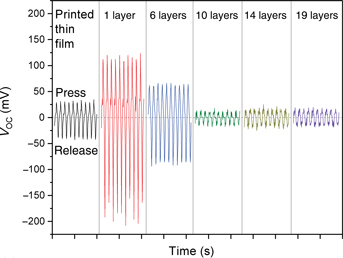Crossref Citations
This article has been cited by the following publications. This list is generated based on data provided by
Crossref.
Mokhtari, Fatemeh
Cheng, Zhenxiang
Raad, Raad
Xi, Jiangtao
and
Foroughi, Javad
2020.
Piezofibers to smart textiles: a review on recent advances and future outlook for wearable technology.
Journal of Materials Chemistry A,
Vol. 8,
Issue. 19,
p.
9496.
McCollum, Jena M.
and
Serrano Delgado, Irene
2020.
Opportunities for Fluoropolymers.
p.
275.
Li, Jun
Long, Yin
Yang, Fan
and
Wang, Xudong
2020.
Degradable piezoelectric biomaterials for wearable and implantable bioelectronics.
Current Opinion in Solid State and Materials Science,
Vol. 24,
Issue. 1,
p.
100806.
Shepelin, Nick A.
Sherrell, Peter C.
Goudeli, Eirini
Skountzos, Emmanuel N.
Lussini, Vanessa C.
Dicinoski, Greg W.
Shapter, Joseph G.
and
Ellis, Amanda V.
2020.
Printed recyclable and self-poled polymer piezoelectric generators through single-walled carbon nanotube templating.
Energy & Environmental Science,
Vol. 13,
Issue. 3,
p.
868.
Yang, Tzu-Chuan
Jiang, Yi-Pei
Lin, Ting-Han
Chen, Shih-Hsuan
Ho, Ching-Mei
Wu, Ming-Chung
and
Wang, Jer-Chyi
2021.
N-butylamine-modified graphite nanoflakes blended in ferroelectric P(VDF-TrFE) copolymers for piezoelectric nanogenerators with high power generation efficiency.
European Polymer Journal,
Vol. 159,
Issue. ,
p.
110754.
Liu, Xingang
Shang, Yinghao
Zhang, Jihai
and
Zhang, Chuhong
2021.
Ionic Liquid-Assisted 3D Printing of Self-Polarized β-PVDF for Flexible Piezoelectric Energy Harvesting.
ACS Applied Materials & Interfaces,
Vol. 13,
Issue. 12,
p.
14334.
Pei, Haoran
Xie, Yeping
Xiong, Yu
Lv, Qinniu
and
Chen, Yinghong
2021.
A novel polarization-free 3D printing strategy for fabrication of poly (Vinylidene fluoride) based nanocomposite piezoelectric energy harvester.
Composites Part B: Engineering,
Vol. 225,
Issue. ,
p.
109312.
Ye, Lanlin
Chen, Liyi
Yu, Jinlong
Tu, Shijian
Yan, Bin
Zhao, Yinghui
Bai, Xue
Gu, Yingchun
and
Chen, Sheng
2021.
High-performance piezoelectric nanogenerator based on electrospun ZnO nanorods/P(VDF-TrFE) composite membranes for energy harvesting application.
Journal of Materials Science: Materials in Electronics,
Vol. 32,
Issue. 4,
p.
3966.
Shepelin, Nick A.
Sherrell, Peter C.
Skountzos, Emmanuel N.
Goudeli, Eirini
Zhang, Jizhen
Lussini, Vanessa C.
Imtiaz, Beenish
Usman, Ken Aldren S.
Dicinoski, Greg W.
Shapter, Joseph G.
Razal, Joselito M.
and
Ellis, Amanda V.
2021.
Interfacial piezoelectric polarization locking in printable Ti3C2Tx MXene-fluoropolymer composites.
Nature Communications,
Vol. 12,
Issue. 1,
Guo, Jiajun
Nie, Min
and
Wang, Qi
2021.
Self-Poling Polyvinylidene Fluoride-Based Piezoelectric Energy Harvester Featuring Highly Oriented β-Phase Structured at Multiple Scales.
ACS Sustainable Chemistry & Engineering,
Vol. 9,
Issue. 1,
p.
499.
Wiklund, Jenny
Karakoç, Alp
Palko, Toni
Yiğitler, Hüseyin
Ruttik, Kalle
Jäntti, Riku
and
Paltakari, Jouni
2021.
A Review on Printed Electronics: Fabrication Methods, Inks, Substrates, Applications and Environmental Impacts.
Journal of Manufacturing and Materials Processing,
Vol. 5,
Issue. 3,
p.
89.
Imtiaz, Beenish
Shepelin, Nick A.
Sherrell, Peter C.
Kentish, Sandra E.
and
Ellis, Amanda V.
2021.
Direct ink writing of dehydrofluorinated Poly(Vinylidene Difluoride) for microfiltration membrane fabrication.
Journal of Membrane Science,
Vol. 632,
Issue. ,
p.
119347.
Zhang, Shuo
Lin, Xiujuan
Liu, Huan
Yuan, Zie
Huan, Yu
Yuan, Xi
Huang, Shifeng
and
Cheng, Xin
2021.
High‐performance flexible piezoelectric nanogenerator based on necklace‐like PZT particle chains.
International Journal of Energy Research,
Vol. 45,
Issue. 4,
p.
6213.
Mokhtari, Fatemeh
2022.
Self-Powered Smart Fabrics for Wearable Technologies.
p.
1.
Ikram, Hamid
Al Rashid, Ans
and
Koç, Muammer
2022.
Additive manufacturing of smart polymeric composites: Literature review and future perspectives.
Polymer Composites,
Vol. 43,
Issue. 9,
p.
6355.
Cardoso, V.F.
Costa, C.M.
Correia, D.M.
Carvalho, E.O.
Peřinka, N.
Martins, P.M.
Meira, R.M.
Marques-Almeida, T.
Rodrigues-Marinho, T.
and
Lanceros-Mendez, S.
2022.
Organic Ferroelectric Materials and Applications.
p.
375.
Han, Cheng
He, Lirong
Wang, Qi
and
Zhang, Chuhong
2022.
Solvent-Exchange-Assisted 3D Printing of Self-Polarized High β-PVDF for Advanced Piezoelectric Energy Harvesting.
ACS Applied Electronic Materials,
Vol. 4,
Issue. 6,
p.
3125.
Corletto, Alexander
Ellis, Amanda V.
Shepelin, Nick A.
Fronzi, Marco
Winkler, David A.
Shapter, Joseph G.
and
Sherrell, Peter C.
2022.
Energy Interplay in Materials: Unlocking Next‐Generation Synchronous Multisource Energy Conversion with Layered 2D Crystals.
Advanced Materials,
Vol. 34,
Issue. 36,
Imtiaz, Beenish
Sherrell, Peter C.
Barlow, Anders J.
Shepelin, Nick A.
Kentish, Sandra E.
Khan, Muhammad Yasir
and
Ellis, Amanda V.
2022.
Non-templated manufacturing of patterned fluoropolymer membranes via immersion precipitation printing.
Additive Manufacturing,
Vol. 58,
Issue. ,
p.
103017.
Mustapha, K.B.
Metwalli, Khaled Mohamed
Baharuddin, Ab Aziz Bin
and
Abakr, Yousif
2022.
3D printing of polyvinylidene fluoride composite films with enhanced electroactive beta-phase for flexible wearable pressure sensors.
Materials Today: Proceedings,
Vol. 70,
Issue. ,
p.
321.



